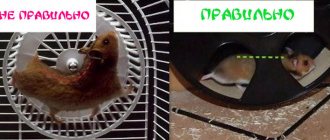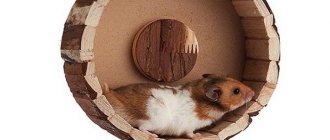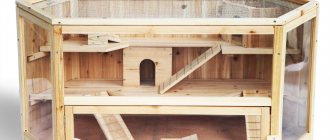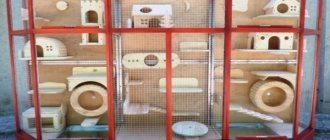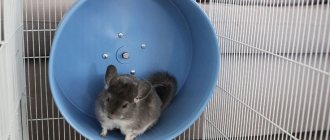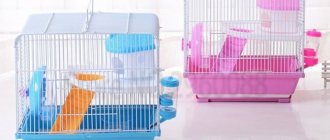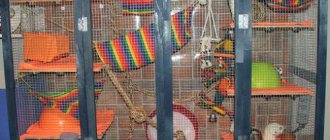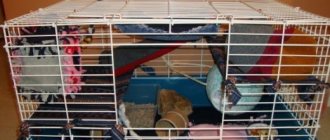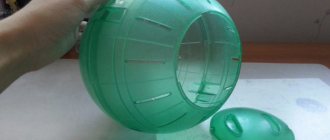Hamsters, leading a very active lifestyle and mainly at night, certainly cause trouble for their owners, preventing them from sleeping soundly at night. If you are faced with similar problems, then it’s time to give your pet a silent exercise machine that will help him splash out energy and not disturb your sleep. Follow the simple instructions on how to make your own hamster wheel at home, so your pet can lead a quiet but active night life.
Why does a hamster love running on a wheel?
Hamsters have an instinct for survival, that is, searching for food and protecting themselves from predatory animals and birds. You've probably noticed that as soon as you let him walk around the house, the first thing he does is examine the corners and places behind the furniture.
Therefore, nature rewarded rodents with increased activity. A wheel in a cage will help to expend the energy generated in the body as soon as it becomes necessary. The speed of movement of hamsters is approximately 5 km/h, which is the same as when a person walks on foot. The hamster's endurance is also surprising. He can run 12 km in 10-12 hours.
Peculiarities
The Syrian hamster is one of the most common representatives among rodents, which is usually kept at home. The animal has certain characteristics that should be discussed in more detail.
First of all, veterinarians and biologists highlight such an unusual characteristic of the Syrian hamster as a changed number of toes: there are 4 on the front legs, and 5 on the hind legs
In addition, it is important to note that rodents of this species often have aesthetically pleasing fur, which is traditionally colored golden. Hamsters can also be beige, black, brown, etc.
d. Moreover, the color can be either uniform (consisting of one color) or include several tones and halftones at once.
Among other things, another unusual characteristic of the Syrian breed of rodents is the length of their coat. Thus, short-haired, long-haired and even smooth-haired individuals are distinguished. Moreover, females have much shorter fur than males.
The birthplace of this animal is considered to be Syria (where the name of the breed comes from). Later, the hamster was brought to Great Britain, and from there it spread throughout the world, including our country.
If we talk about the biological characteristics of a rodent, it is important to note that its body length usually does not exceed 12 centimeters in the wild and 20 centimeters at home. Weight varies depending on the sex of the rodent: females can weigh up to 140 grams, and the weight of males, in turn, usually does not exceed 125 grams
However, there are exceptions, the weight of which reaches 200 grams.
What materials are best to make it from?
You can make a wheel from many available materials:
- Tree. Wooden wheels are made from small boards. Ice cream sticks are perfect for this purpose. You will also need a rectangular wooden beam and metal wire. Such a wheel turns out to be durable and requires virtually no financial costs. But if it is not weighted down from below, then it can turn over while running, since it weighs very little.
- Tin can or disk. To make it you will need a tin can of the required size, a screwdriver, a knife for cutting metal, a glue gun, and wire. The design is also quite durable. But if the edges of the jar are not treated, the hamster may cut himself on them. In addition, this design does not look very aesthetically pleasing.
- Cardboard. This wheel is suitable for small rodents, as it is not durable. The design is very simple to make; even a child can do it under the supervision of an adult. Be sure to choose a thick cardboard so that it does not sag under the weight of the hamster.
Have you decided to make a wheel from natural materials?
Cardboard
If you find out how much it costs to buy a trainer and decide that it’s not affordable for you, you need to make the toy yourself at home. The best wheels are made from cardboard; they are convenient for training your hamster. This design is safe and does not creak.
So let's start assembling. To build the toy, we will need to make two circles from cardboard, the size of which corresponds to the parameters of your pet. On one of the circles we cut out a passage for the hamster. Next, in a circle, we make small notches in the form of triangles along the edges. We will also cut out the wall and base to which the circle will be attached. The path should be cut in accordance with the rectangular cut-outs on the circles.
Assembling the cardboard structure:
- we insert the track so that the protrusions on it intertwine with the holes made;
- secure the base to the wall;
- insert the metal sleeve;
- We take the bushing and put one wheel on it, and then the second.
The main disadvantage of this method is that cardboard is short-lived and can be eaten by animals. Advantages: low cost and ease of preparation at home.
What you need to do it yourself
To make a homemade wheel you will need:
- wooden board as a base;
- stick as an axis;
- compass;
- sandpaper;
- ruler;
- hacksaw;
- stationery knife;
- pencil;
- scissors;
- perforator;
- materials for the wheel body (wooden sticks, cardboard, metal or plastic container, wire).
Important! Small children cannot use cutting objects on their own, so you need to call your parents for help.
Varieties
Modern hamster wheels come in a wide variety. Many people make this accessory themselves. In any case, you should initially familiarize yourself with the design options in order to make or choose the best option. So, let's take a closer look at the types of hamster wheels depending on several criteria.
To size
Wheel dimensions play a big role. If you purchase a small wheel, the hamster will have to sag when running, which will negatively affect the animal’s posture and may even result in injury. The very large accessory is quite difficult to rotate, so the hamster may even refuse to use it.
If you need an accessory for a Djungarian hamster, you should take a wheel with a diameter of 12 to 16 cm. But for a Syrian hamster it is better to take a wheel with a diameter of 18 to 20 cm
It is worth paying attention to the width of the accessory, because a small width will lead to the animal constantly falling out of it. So, for Syrian hamsters the ideal width is 7 cm, but for dwarf representatives - 5 cm
If the gap between the accessory mount and its rotating part is less than 1 cm, then there is a high probability of injury to the animal. If the wheel dimensions are chosen incorrectly, you can expect dislocations and fractures.
Based on materials
This attraction can be made from several materials.
Natural wood. The safest is a wooden wheel, but, unfortunately, it is characterized by the highest cost. If the hamster wants to taste the simulator, then nothing bad will happen.
For example, a plastic wheel presented on a metal stand will be an excellent choice, because plastic parts are characterized by lightness and noiselessness, and a metal stand guarantees the power and reliability of the entire structure.
It is also worth paying attention when choosing a treadmill. It should be non-slip, especially if you consider a model made of plastic or wood
It will be uncomfortable for the hamster to run, and at high speed he may simply fly out. If the mesh is made of metal, you should give preference to a fine-mesh one, because the animal’s paw can fall into a large mesh.
By mounting method
Depending on the mounting method, there are three types of hamster wheels.
- On the wall of the cage. In this case, special holders or strong wire will be required, depending on the type of cage. Using this fastening method, you can save space, but it is worth remembering that this option involves tapping on the hamster’s house itself while running. The option of mounting on bearings is often used.
- To the bottom of the cage. This wheel is presented on a special stand. This is what guarantees the safety of using the product. The stand must be secured to the bottom of the cage. The disadvantage of such fasteners is that the structure cannot be called reliable and safe.
- Standalone device. The wheel is mounted on a stand, so installing it will not be a problem. This option allows you to minimize the possibility of the wheel tipping over.
In addition, it is worth noting the running disc. This option is additionally equipped with a stand, which gives it stability, since the hamster cannot fall out of the structure. When choosing types of construction, you can also mention a walking ball.
Step-by-step instructions: how to make a hamster wheel with your own hands at home
Before starting the manufacturing process, you need to study the structural features of a hamster wheel, decide on the size and other characteristics. This will help you make the perfect wheel that your rodent will definitely love.
Running wheel diameter
The most important thing is to choose the right wheel size so that your hamster can run comfortably in it:
- a diameter of 12 cm is suitable for a young hamster;
- for an adult rodent 16-18 cm;
- jungarika – 10 cm.
Important! As your pet grows up, he will need to change the wheel to a larger version.
Surface of the running wheel
The hamster should be comfortable running in the simulator. Therefore, the inner surface must be made ribbed. The rodent will be able to grab onto it with its paws and rotate the cylinder. Corrugated cardboard works well for these purposes. If you are making a wheel from plastic or metal, you will need to cover the inner surface with fabric.
Made of wood
You can make a wooden wheel according to the following instructions:
- Take a thin board and draw 2 circles with the selected diameter.
- Cut out one of them whole, and inside the second, draw a circle with a diameter less than 1 cm and cut it out too.
- On a solid circle, make a hole in the center and several more small holes around it.
- Take the popsicle sticks and cut them so that they are 5-6 cm long.
- Connect both parts using sticks and a hot gun, creating a wall for the rodent to run along.
- Using a nut and screw, screw the wheel to the wall of the cage.
From a hard drive and a jar
You can make a hamster wheel from a can in half an hour using improvised means:
- Select a container of the required diameter.
- Measure 5-6 cm from the bottom along the wall and cut off the excess.
- Sand the edges and interior surface with sandpaper.
- Take a cocktail tube and connect 2 points of the circle with it so that it runs through the center.
- Glue the edges with tape or a glue gun.
- Make holes in the center of the bottom of the jar and in the middle of the straw.
- Stick a wooden skewer into them.
- Check that the wheel rotates freely along the axle.
From cardboard
It’s as easy as shelling pears to make a wheel out of cardboard paper:
- Draw on cardboard and cut out blanks for the future wheel with a stationery knife: two circles of the same size with holes for the rodent, 2 parts in the shape of the letter “P” for attaching the wheel, a strip 5-6 cm wide and equal to the length of the circle.
- Bend the strip, connecting its edges, and glue it between the circles.
- Take a knitting needle and thread it through the centers of the circles.
- Attach the sides.
- Bend the ends of the knitting needles so that the circle does not fly off.
Nuances in making a running wheel
When working on the simulator, the following points must be taken into account:
- the wheel must rotate freely around its axis;
- it must be stable and not lose balance when a hamster gets into it;
- Don't forget to trim the edges so your pet doesn't get hurt.
Important! Remains of glue must be removed from the surface so that the rodent does not accidentally swallow it.
A few ideas
All hamsters love to have fun on rides. We'll tell you how to do some of them. Especially small animals like to ride down the slide, run up the stairs and explore the labyrinths. We will start with them.
Slide
Although hamsters are cowards, many of them willingly roll down the slide. Learn tips on how to make a hamster slide and make your pet's dream come true!
The best materials for making this attraction are plastic and wood. But the wooden surface must be thoroughly polished, otherwise the hamster will not slide on the slide, and it can also cause splinters on its paws. Here are ideas for creating this thing:
- Straight slide made of wood. Do you have a small smooth piece of wood? The required length is about 20 cm, and the width is 10. Just place it at an angle of 30º to the floor - and you can roll the fluffy one. This is a temporary structure designed for playing with your pet outside the cage.
- A slide of ducks. If your kids have utiki (short skis), they are ideal for playing with your pet. One ski should be taped to any support, with the rounded toe pointing down, it will ensure a smooth landing on the floor.
- Old toys. Many children have doll water parks at home. They will willingly share the slide with the hamster, because playing with the animal is more fun than with soulless toys.
- Shampoo bottle. If you have cylindrical cosmetic bottles left, cut off both ends and cut the bottle lengthwise into 2 parts. Make a ladder with a support from wood. You can also prepare a landing site. Then all that remains is to install half the bottle and roll your furry friend.
In the latter case, it is not necessary to use a bottle - this is rather an option for the Syrians. For small dwarfs, you can build a PVC slide using the outer shell of a garden hose. This is what it will look like:
Ladder
The pet will climb up the stairs to the second floor of the cage, which can also be used to create an obstacle course. It can be straight or curved. You can make the following types of ladders for your hamster with your own hands:
- From sushi sticks. The supporting slats are made from long sticks, and the short crossbars are glued to them.
- Ladder-ladder. It is very easy to do: transverse slats are glued onto a solid wooden plank to act as steps.
- Made from twigs and wire. You need to select branches with a diameter of 1 cm and alternately connect them at both ends with wire. This staircase is good because it easily turns into a bridge!
- From a broken running wheel. Cheap wheels often break, but they can be given a second life! To do this, carefully cut off the back wall with a knife. You will get a circle with slats. Now simply open the wheel by making 2 cuts on the circles. The resulting ladder can be given an interesting shape, because cheap plastic bends well.
A ladder made from a running wheel can also be used as a bridge or element of an obstacle course.
Types of simulator and mounts
Running wheels differ in their inner surface. It can be solid, lattice or mesh. It is safest to choose wheels without holes so that the hamster's paw cannot fall into it.
Wheels also differ in the type of fastening:
- to the cell wall. Saves space in the hamster's home, but when used it knocks on the rods or board.
- To the bottom of the cage. Such exercise machines are unstable and can tip over if the rodent starts to run.
- On a stand. The best option for hamsters if space in the cage is not limited. Very stable and causes minimal noise.
Cardboard
This type of simulator is very inexpensive, but not durable . In addition, the hamster can chew on it significantly during a break between runs. Anyone can make such a wheel, even without special skills.
This is a great option for hamsters who are just starting to run or as a temporary trainer until you get a more durable one.
Silent
Many people choose this type of exercise machine because hamsters love to run at night. The noise from the rotation of the wheel can be heard all night and interfere with sleep.
Thanks to the special design, the parts do not touch each other and do not create extraneous sounds. But it is worth noting that such wheels are much more expensive than regular ones.
Wood
A wooden treadmill keeps the environment around the rodent environmentally friendly. This is a big plus for his health. These wheels are a little more expensive than regular ones, but you can make them yourself.
Features of the structure of the running wheel
Any running wheel consists of a cylinder, which is mounted on an axle. When choosing a simulator, it is important to ensure that it rotates evenly and does not deviate to the sides. The wheel stand must be stable. Otherwise it will turn over.
Important! The design of the wheel should not contain foreign objects, for example, to decorate the simulator. They will interfere with the hamster's running and may cause injury.
Requirements
The main criteria when choosing a cage are its comfort and safety for your pet. In addition, the future home of a furry friend should be comfortable for its owner. The owner needs to select in advance the place where the new home will be located, and also select a product for a certain size, no less than the minimum recommended for a dzhungarik.
The materials from which the cage is made must not only be durable and strong, but also safe. Rodents taste everything they see, so the grill bars they try should not be harmful to the health of the animal.
Choose a cage that is easier to clean. It is more convenient to buy a product with a pallet. Be sure to check that the door closes well.
Djungarians are very curious creatures, prone to escape, and a weak locking device may not withstand its sharp teeth. Try to buy a home with built-in attributes in advance. This will be a more economical option, and in the future you won’t have to think about where and how best to install all the additional devices.
Materials
Pet stores offer several options for hamster cages.
Made of metal rods. A good ventilated home in which the rodent feels quite comfortable. The inconvenience is that the noise the hamster makes can be clearly heard through the bars, and dirt always forms around. Filler and debris easily penetrate through the bars. The grill itself should be made of high-quality solid metal.
Do not take products made of copper or aluminum - the animal gnaws everything, so it will quickly render such rods unusable.
Plastic or glass aquarium. In such a closed home, the noise level is significantly reduced, and there is almost no garbage. In addition, this is the safest option for a home where there are cats - it is unlikely that a predator will get to the rodent, which is kept in an aquarium under a breathable mesh. However, the hamster himself will be uncomfortable in such a home, since it does not allow air to pass through well.
The inconvenience for the owner is that the aquarium is difficult to clean.
Lattice cage with plastic tray. This is the most preferred option. This cage is easy to clean. If the home is two-level, and the “floor” of the second floor is made in the form of a lattice, then check whether the pet is injured by getting its paws or abdomen stuck between the bars. If the risk of injury is high, cover the second level with cardboard.
It is recommended to buy cages in which the second floor is made of plastic and reinforced with high quality. Try to avoid wooden elements in the cage, as wood absorbs unpleasant odors and also becomes a favorite material for grinding down the rodent's incisors.
Designs and sizes
The length of the cage for one dwarf hamster should be at least 50 cm. This is even longer than for a Syrian hamster. And although the Syrian is larger in size than the Djungarian, the miniature pet still has to run a greater distance per day, so it needs a more spacious cage. If the cage is purchased without additional equipment, then do not forget that the area will be reduced due to the established mandatory attributes.
Another important point when choosing a cage is the gap between the rods. It should be no more than 10 mm.
Give preference to a cage with horizontal bars - rodents like this shape more, and it is much easier to attach additional devices to a horizontal grid for a comfortable life for a rodent.
If the distance between the rods is greater, the hamster will definitely try to escape. And even if the cage contains a fairly well-fed individual, this factor does not deprive it of its plasticity.
If you purchase a very spacious cage, then do not forget that cleaning the hamster is done quite often, and the large dimensions of the cage will significantly complicate this process.
However, if the owner keeps several hamsters at once and plans to breed them, then it is better to opt for a large cage. It is worth mentioning separately about the day of the dwelling. It can be with a retractable mechanism or high. A retractable bottom is much more convenient in terms of cleaning, but a cage with a high bottom is suitable for breeders, since the high sides will prevent curious little hamsters from falling out of the cage.
Disadvantages of purchased hamster wheels
The main disadvantage of purchased wheels is their cost. A medium-sized exercise machine will cost no less than 700-1000 rubles. Plastic wheels may contain harmful impurities that will worsen the hamster's health.
Often, purchased hamster wheels are coated with paint that a rodent can tear off with its teeth. If it gets into the animal's stomach, it can cause intoxication. Therefore, things made with your own hands are sometimes safer for your beloved pets.
Wood
If you have the talent of a carpenter, then you can make a wooden product with your own hands. A circle made of such material has a greater range of uses. The deal of a wooden attraction is very clear, it is similar in every way to a cardboard assembly. If desired, you can decorate the product: beautifully intertwine with vine or willow.
The most important thing is to ensure the safety of the hamster and not to build an attraction with a small number of planks. After assembly, the simulator will require care and proper use.
- If you hear that the walking wheel in your cage is squeaking, you should lubricate it from a bottle of machine oil.
- For safety reasons, the simulator is located in a cage or a huge box.
- At first, the hamsters do not understand the purpose of the attraction. To quickly accustom rodents to training, they should be lured with something tasty during training.
- Wash the wheel 3 times a month.
As you can see, making a wheel for a restless hamster with your own hands is not difficult. The main thing is to show a little imagination and patience. Please your pet, and he will be grateful to you for the leisure time provided.
slonvkvartire.ru
How to train a rodent to run
Some hamsters don't understand why they need a wheel until they try to run in it. Others become lazy over time and don't want to move much. Experts recommend using the following tricks:
- Lure with a treat. You won't give your hamster a choice if you put food directly into the drum. You need to do this for several days in a row until the rodent itself begins to come and climb into the wheel.
- Blocking the exit. Take a piece of cardboard or a piece of wood and cover the entrance to the wheel with it when the hamster gets into it. He will only have to move in one direction, causing the wheel to rotate.
Tips for use
Naturally, there is nothing complicated or incomprehensible in such a piece of furniture for a hamster . But it’s worth listening to some recommendations.
- Do not remove the wheel from the cage. The rodent needs access to it at any time.
- Baby hamsters do not immediately understand why they need this device in the house. At first, you should put a treat inside the toy. When getting to the provisions, the baby will put the simulator into action.
- Don't forget to wash your wheel regularly. Once every two weeks is enough for this procedure.
Possible problems
Even using such a simple design can cause difficulties. Most often, hamsters refuse to run in a wheel. It also happens that over time the wheel begins to squeak.
The wheel squeaks
The structure may creak as a result of prolonged use. The parts deform over time and come into contact with each other during rotation. The solution is to lubricate the surfaces with oil. If a new wheel squeaks a lot, it may be defective.
Hamster doesn't run on a wheel
This problem can occur for several reasons:
- The rodent doesn't like the wheel. Try replacing it with a machine made of a different material or with a different design.
- The hamster has a hard time turning the wheel. This may happen due to the age of the animal. Rodents older than 2-3 years are considered old and they lose the desire to move a lot.
- The hamster has an injury. It may also happen that the rodent injured its paw or hit itself. Find out by watching him. If he used to be cheerful and active, but suddenly suddenly stopped running and playing, you should take him to the vet.
Manufacturing
Before you start making an attraction for your pet, you should at least understand in general terms what a jogging wheel should look like.
- The attraction must be of suitable size. The animal should not be cramped inside, otherwise it will not be able to move comfortably. Excessively large dimensions of the running structure are also undesirable. It will be very difficult for a hamster to spin such a wheel with its paws. For an adult Djungarian hamster, a diameter of 14-16 cm is suitable. For animals of the Syrian breed, it is better to make the attraction larger, since they are larger. For an adult, the diameter of the circle should be at least 20 cm.
- The width of the treadmill also matters. If it is not wide enough, the hamster will periodically fall and may get injured. For small and medium-sized individuals, it is better to make a simulator 5 cm wide. For larger breeds, a track width of 7-8 cm is recommended.
- The running wheel should turn easily. Otherwise, the animal will quickly get tired and may lose interest in its attraction.
- It is worth taking care that the pet does not injure its paws during exercise. This directly depends on the material and structure of the treadmill surface. If you decide to use mesh materials, then make sure that the cells are as small as possible. Otherwise, the hamster's paw may get stuck in them while running. And also, the simulator should not have sharp jags or bumps that the hamster could trip over.
- The treadmill inside the wheel should not be slippery. Therefore, a smooth plastic surface should be covered with thick cloth in advance. The pet will be able to cling to it with its claws.
- When installing the wheel, care should be taken to ensure that it is securely fastened . The animal moves quite intensely on the track, and the shaky structure can topple while it runs. Therefore, the treadmill must be attached to the bars of the cage or placed on a strong and stable support.
To make a wheel, you can use various available materials.
